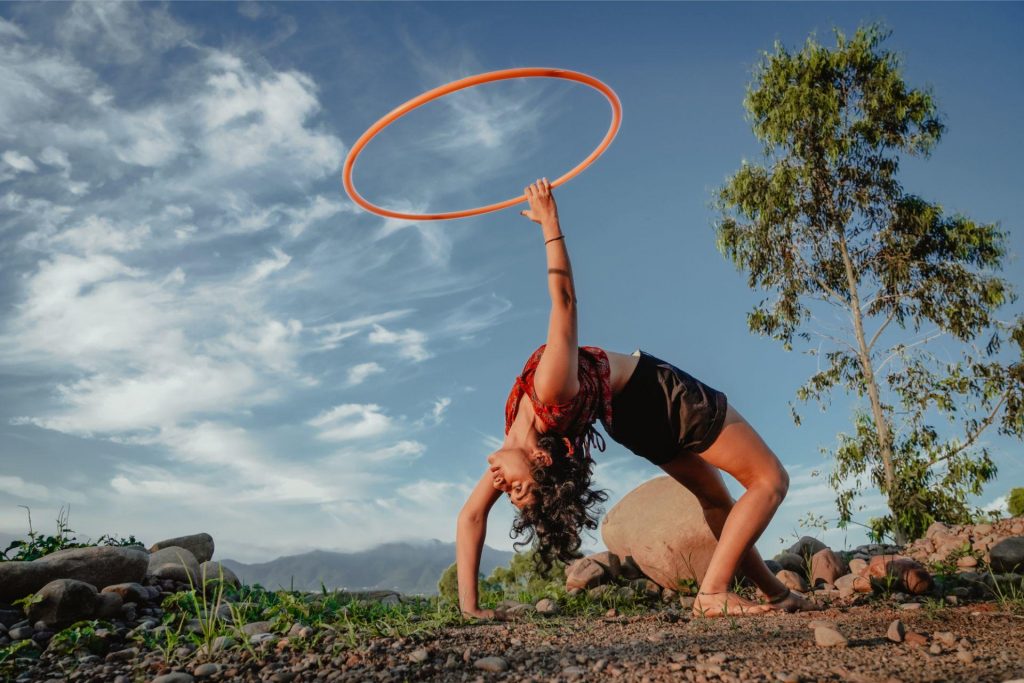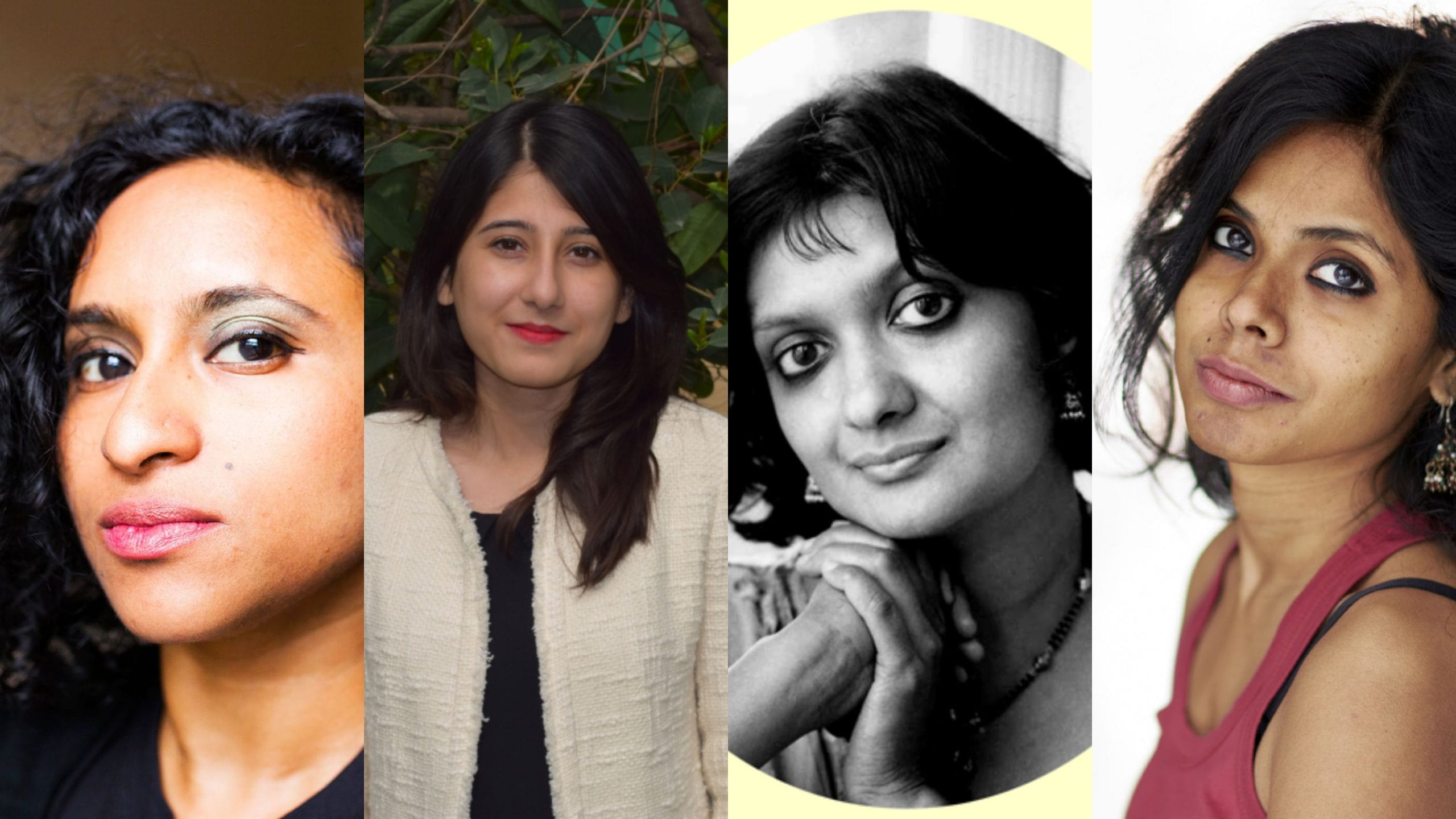Eshna Kutty has taken the internet by storm with her wonderful Hula-Hoop rendition of AR Rehman’s classic song Genda Phool in a sari and Puma sneakers. She put out #sareeflow as a hashtag to help people feel comfortable and happy wearing it without the pressure of being a delicate lady. With this idea, Eshna has set out to create a space for fellow hoopers where it’s considered to be more than just a hobby.
Her journey with dance and hooping began when she purchased her first Hula-Hoop around 11th grade. Eshna says that she has no background in dance. “Whenever I saw dancers, I always had these general notions that dance was a lot about beautiful bodies. Dancing was never something I took on to simply because I thought I couldn’t do it. I thought it was very difficult and needed a certain amount of flexibility and strength which at the time I didn’t have“. That’s when Eshna got into hooping and started practicing it in her bedroom, something she now calls “bedroom hooping“. She discovered that you could do a lot more than hooping just on the waist which is what people think it is.
But whenever I saw dancers I always had these general notions that dance was a lot about beautiful bodies. Dancing was never something I took on to simply because I thought I couldn’t do it. I thought it was very difficult and needed a certain amount of flexibility and strength which at the time I didn’t have“.
“Back when there was no such thing as Instagram it was kind of just bedroom hooping for me. No one ever actually saw me practicing with it up until two years after I had gotten into it.” For Eshna the struggle lies with finding validation for what she does. Earlier, it was harder for her to explain what Hula Hooping meant to everyone else around. But, now with social media, she believes that she doesn’t really have to explain much because people can just see what she doing and that’s enough.
Beginnings With Hooping
Eshna recalls how dance for her happened when she had to apply for college. She signed up for the ECA category and got in. As a bond, she ended up having to represent the dance society for two years.
“Dancing in the DU circuit means that you’ve got to wear sexy attires and do those dance numbers. The Western Dance Society was a lot about the perfect body kind of workout but at the same time, I found it very empowering and cathartic. Like in the sense that I was always a very close person and expressing with my body made me feel more confident. It made me feel very good about myself“.
Eshna also pursued her Masters at TISS, Mumbai where she studied Movement Therapy. That’s when she realised that when we truly become one with our body, we’re also one with our mind. We tune in and out of our body awareness all of which makes the experience really incredible. For her, even though hooping started as a workout, it turned into this emotional journey which made her emotionally and mentally more flexible.
Also Read: Unearthing ‘Curry’ — A Magazine That Pulls You Into The World Of Stereotypes
The Stigma Around Hooping
The stigma attached to a woman hooping or doing dance forms like belly dancing is huge. In college, Eshna would perform and kept getting invited by corporates or other platforms that would want her to perform for entertainment. She recalls that, “At the time because money was something I needed, so I would perform and I would always feel really bad about myself. You don’t get the respect you expect from the hard-earned hours of practice you put into the performance.”
Additionally, a lot of times the invitation for performances is not from a place of respect but more about. “we need some girls and this kind of a profile.” However, Eshna also believes that she’s not here to make a statement that people should not be performing in such places. “I genuinely think that if this gives them the joy they should absolutely do that. But I know it was not my personal cup of tea”. I feel like empathy goes a long way. So when people kind of connect with you and empathize with what you’re feeling then that makes all the difference. That’s pretty much why today I’m more of a teacher than a performer. I realised that personally, I get a lot of joy from being able to share this tool with other people because I like it so much!“.
At the time because money was something I needed, so I would perform and I would always feel really bad about myself. You don’t get the respect you expect from the hard-earned hours of practice you put into the performance”.
Q1. How did you get into teaching? Tell us a little bit about the Hoop Flow Program.
I have been teaching even before I was even performing. When I was in college I got invited to take a workshop at a Belly Dancing School. I really liked it but for the next three years whenever I set up workshops nobody would show up. Because hooping was so new, everyone was a little apprehensive of what exactly they would do in a Hula Hoop class. But, I always had a sense of being extremely under-confident and overcritical. So, even when I was improving with my skills it just never felt good enough. It was only until I sat down to think and realize that literally in a country with billions, there are only a handful of people who do this professionally. I knew I had something to give back and took a leap of faith. Towards the end of my post-graduation, I decided to give one year to just teach and spread this skill in some way possible. That’s when the pandemic happened.
I knew that when I wanted to teach in a way that it should not be a Hula Hoop class to just get thin or flexible but it would tap more into wanting to create a space for not just women but all genders and age groups where people are so in love with their bodies and just happy. My training in movement therapy also played a huge role in the way I teach Hula hooping because I use a lot of tools from movement therapy.
Also Read: Malavika Anupraj: As ‘Ambotti’ As Art Can Get!
Q2. Has the pandemic affected your teaching in any way?
I was one of those few people who got lucky with the pandemic. Something that I do become a very trendy lockdown habit where suddenly people started going to my profile and finding what I do fun.

Otherwise, most of the audience would just be watching it and passively going through my feed. I noticed through the in months of lockdown more and more people were coming in. It’s simply because they now had the time to indulge in a new activity. Infact, in the first few set of batches, we were able to create a kind of space shared not just by me but by everybody in the team. That kind of positivity energy just throws on to my feed where other women and some men (very few but some anyway) would just get so inspired by what I was doing.
Q3. What has been your personal journey with hooping? How do you translate that into the work you do now?
I used to feel very safe and even now if you take a hoop away from me I feel quite naked. With that feeling of comfort that I got from hooping, I was able to become more confident in my own skin. And that made me be more comfortable with my body and mannerisms when the hoop was away. Even as I teach now, I notice in my students that hooping literally has two things to it: one is finding comfort in your body and the other is finding comfort with your body making contact with another object. But in a literal sense, it means being comfortable in your surroundings. I think these little things make a huge difference.
Coming Up Next
Hoop Flo (without the w, because we’re futuristic) has now become a brand. For Eshna, her company is going to be a one-stop destination for all things hoop related. She plans to have a shop that is going to be one of the first shops selling high-quality Hula Hoops with customizable options. Other than that, she plans to have more pre-recorded self-based programs that are set to launch this month. For her, the Hoop Flo tribe in the last few months has become a strong group of almost 200 women. Even though it’s a larger number, everyone is still passionately hooping and sharing videos on their groups. This one-stop destination will allow people who come in knowing nothing about Hula hooping to learn and become a part of the tribe. Eshna also plans to bridge the gaps between Indian hoopers and Foreign hoopers and hopes to make one big family across the globe.
You can know more about her work through her Instagram and Website.
About the author(s)
Trying to find her sociological imagination. Often finds solace in books and some soulful Sufi music.




